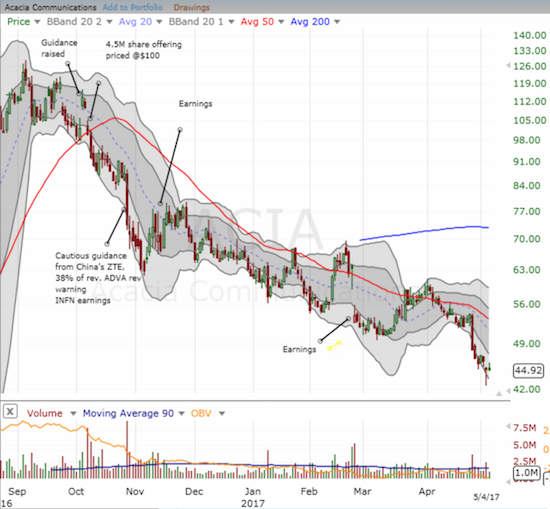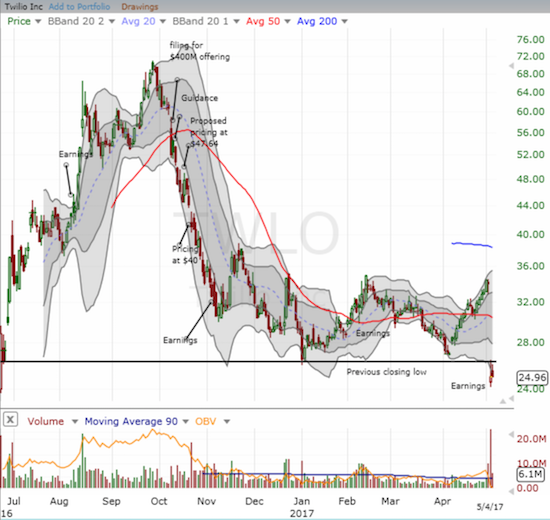A little over six months ago, I made a bearish case for Acacia Communications (ACIA) and Twilio (TWLO) based on the way each company rolled out follow-on stock offerings and the market’s reactions to the selling. Since then, ACIA and TWLO have fully lived up to bearish expectations. ACIA is down 55.1% from its offering and down 35.5% from the time of my post. TWLO has lost 37.6% from its offering and 26.8% from the time of my post.


Source: FreeStockCharts.com
My negative opinion started from offerings which followed closely after the IPO (less than 6 months) and went mostly (if not all) to cash out selling shareholders instead of raising funds for the business. Such a rush to sell raises the yellow flag of shareholders who suspect that the getting will not likely get better.
My suspicions grew given the proximity of guidance to the offerings. ACIA delivered news of its offering immediately on the heels of strong, between-earnings guidance. A cynic might note that the good news served as a potential prop for an extremely high-priced stock that could be vulnerable to a sharp decline in the face of a large liquidity event. When ACIA had to offer shares at a price 11.5% below where it closed after issuing guidance, I further suspected valuation issues.
TWLO issued guidance after announcing the offering. News of the offering sent the stock down 14.1% before pricing was even revealed. Guidance came the next day but delivered only a brief respite to the rush for the exits. As the stock continued to sell-off from there, TWLO had to offer a price 8.4% below the close following the first sell-off. With selling continuing, TWLO marked down the price further to $40.
Poor technicals sealed the deal. In both cases, traders and investors reacted very poorly to the offering. Selling pressure was heavy and nearly unabated. The market spoke loud and clear against ACIA and TWLO.
TWLO’s earnings collapse is particularly instructive. The company had to reduce guidance because Uber, its largest customer, decided to rein in ballooning spending with the company. From the Seeking Alpha transcript:
“…Uber grew as a percentage of total revenue in each quarter throughout 2016, ending the year at 17% of our revenue in Q4. In the first quarter of 2017, Uber accounted for roughly 12% of total revenue and as Lee will outline in a moment, we expect their contribution to decline further this year. Uber continues to grow rapidly, but they’re changing the way they utilized and consumed communication services.
Previously, they used our platform to support most of their used cases in majority of their operating territories. Now, they’re optimizing by used case and by geography, resulting in a more active multi sourcing program. In addition, they plan to move communications for some of their used cases inner. We believe that Uber will remain an important customer for us going forward, but their tremendous growth and the resulting magnitude of their communication spend has resulted in this change and approach.
While it’s not uncommon for large companies with mission critical used cases to dual source key technologies, communication included. There are very few companies in the world with the global scale and engineering promise to take on a project of this magnitude. Most companies are unwilling or unable to navigate the complexities of integrating into multiple vendors and optimizing on a geographic level for each specific used case, much less taking on the risk inherent in doing so.”
This explanation was a great reminder of the dangers of investing in small companies whose revenue is dominated by a few very large customers. TWLO tried to reassure investors:
“…after Uber and WhatsApp, we have very little customer concentration. Our third largest customer is about 2% of revenue, with a gradual slope after that across the rest of our customer base. So while the changes in our relationship with Uber will restrain our overall growth in 2017, this does not change our belief about the health of our business or a long term outbreak.
Absent Uber, our base revenue grew by 60% year-over-year in Q1, a level of growth that we have met or exceeded consistently throughout recent periods.”
In an interview with Mad Money’s Jim Cramer, Co-Founder and Chief Executive Officer Jeff Lawson essentially reiterated these points. He also reassured Cramer that the company is not facing a cash crunch (fortunately the company stuffed its coffers alongside selling shareholders). Cramer was an early booster of the stock (as I pointed out in my post last year), so he issued a mea culpa on his May 4th show. Hey, it happens even to the best, but I was a bit surprised Cramer ignored all the warning signs going into the $40 pricing of the follow-on offering; granted he did note the stock had to hold $40 and trade higher to confirm demand for the stock. Cramer was much more cautious after the interview and urged his audience to do its research before deciding to take advantage of today’s discount. Given TWLO’s collapse, the trade from here is pretty simple: short on a new all-time low or buy after a new post-earnings (intraday) high. Note well that the bears are already all over TWLO to the tune of 33% of its float sold short. Sentiment is similarly bearish for ACIA with 32% of its float sold short. ACIA next reports earnings on May 9th…
Be careful out there!
Full disclosure: no positions
